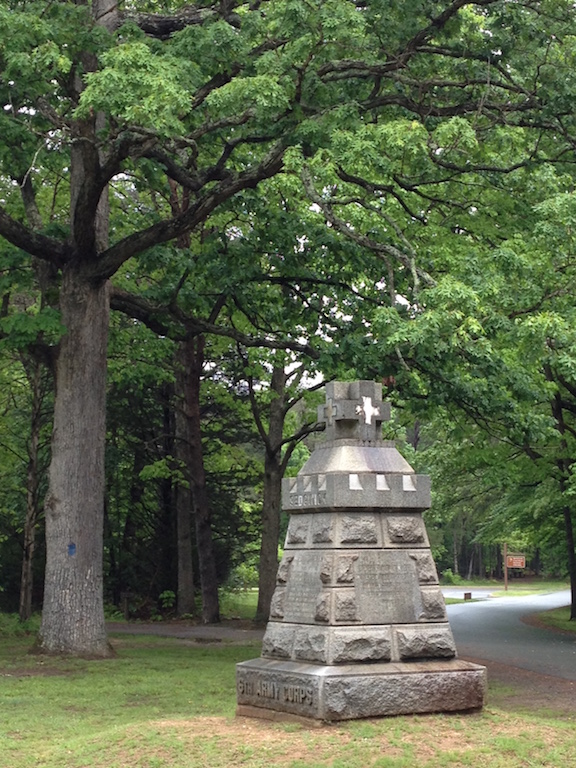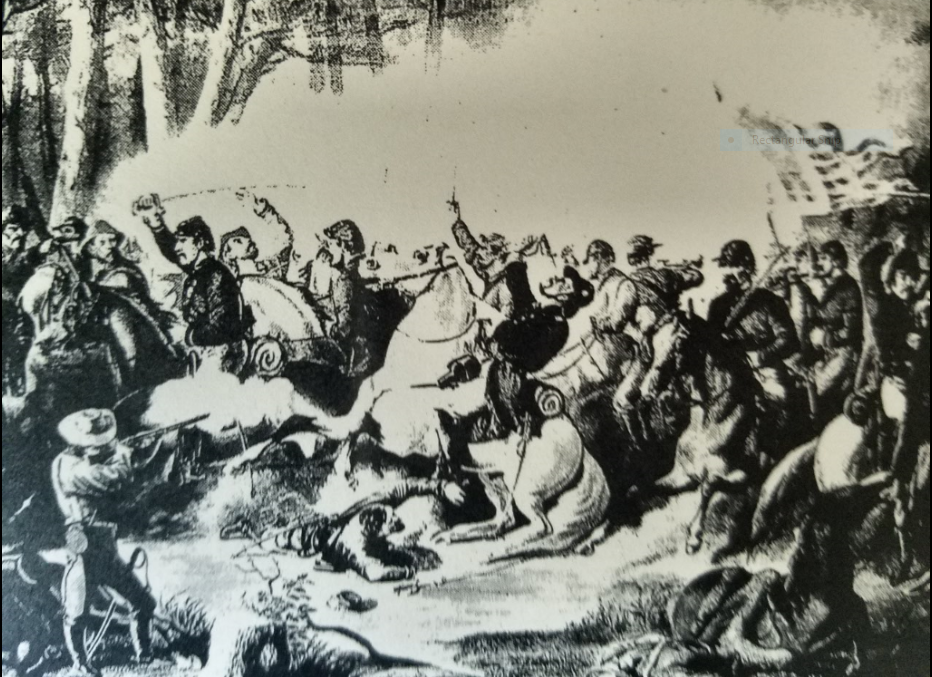Impressed with Coming Disaster: Alsop’s Field at Chancellorsville

On May 9, 1864, Maj. Gen. John Sedgwick, commanding the VI Corps in the Army of the Potomac, was killed at Spotsylvania Court House. Visitors to the battlefield can walk from the Exhibit Shelter to a monument that stands on the spot where the Union general fell. In doing so, they pass through the midst of a forgotten episode in the Chancellorsville Campaign. Along the rolling fields north of the monument and outside the National Park Service boundary, Union and Confederate cavalry clashed on the night of April 30, 1863.
Major General Joseph Hooker, commander of the Army of the Potomac, envisioned a two phased plan for the spring campaign of 1863. Rather than attack Robert E. Lee head on at Fredericksburg, Hooker planned to use his cavalry as a crowbar to pry the Confederates away from the Rappahannock. Major General George Stoneman’s blue horsemen would ride around Lee’s western flank and then strike south, severing his lines of supply and communication with Richmond. This would force Lee to withdraw and with Hooker’s infantry in close pursuit, the two armies would clash somewhere north of the Confederate capital.
Hooker, however, did not count on Mother Nature. Heavy rains delayed the cavalry expedition and by the time Stoneman got underway, Hooker had decided to alter his plan. Instead of waiting for Lee to retreat, three of his infantry corps would follow the cavalry, turn Lee’s left and then move on his rear at Fredericksburg. Stoneman’s departure left the Union army with only a brigade of horse soldiers under Col. Thomas C. Devin. Devin’s former regiment, the 6th New York Cavalry, drew the assignment of screening the infantry column.
On the morning of April 27, 1863, the New Yorkers left their camp in Stafford County and marched via Hartwood Church to Kelly’s Ford on the Rappahannock. Crossing the next day, they moved out ahead of the XII Corps. After a brief encounter with the 1st North Carolina Cavalry, the regiment continued to Germanna Ford on the Rapidan. Following a sharp fight with Confederates on the south bank, the New Yorkers pressed on over the river. The march continued on April 29 and by the following afternoon, the Empire Staters, along with Hooker’s infantry had reached a crossroads west of Fredericksburg called Chancellorsville.
Upon their arrival, Maj. Gen. Henry Slocum, head of the XII Corps directed the regiment’s commander, Lt. Col. Duncan McVicar to proceed on to Spotsylvania Court House. Slocum indicated that McVicar would rendezvous with Union troops there. This assignment did not sit right with McVicar and when he returned to clarify his directive with Slocum, he was summarily dismissed.

This “rather curt reply had a depressing effect on our Lieutenant-colonel” remembered the regimental adjutant, “and from that time he appeared saddened and serious.” Soon after leaving Chancellorsville, McVicar addressed his men. “The speech as a whole had a bad effect, for we felt impressed with coming disaster” an officer recalled.
The regiment trotted along a road which was “scarcely wide enough for “column of fours”, and flanked by woods nearly the entire distance.” Darkness soon descended and a half moon appeared in the night sky. Reaching a point several miles north of Spotsylvania, McVicar dispatched a squad ahead to reconnoiter. Shortly after they departed, gun shots erupted at the rear of the column. As the firing increased, the squad returned with word that their path was blocked by enemy troops. McVicar quickly ordered his men off the road through a nearby gate and into a clearing owned by Hugh Alsop.
The Empire Staters had indeed stumbled upon Maj. Gen. James Ewell Brown “Jeb” Stuart and elements of Brig. Gen. Fitzhugh Lee’s brigade. Stuart had been monitoring Hooker’s infantry since it had crossed the Rappahannock. Trying to stay clear of the Federals, Stuart had skirted off to the south in the direction of Todd’s Tavern in an attempt to reach friendly lines at Fredericksburg.
Once in Alsop’s Field, McVicar faced the regiment about just as more volleys tore into the New Yorkers. Then Lt. J.H. Bell rode forward and after a brief exchange, confirmed that the 3rd Virginia Cavalry stood directly in their front. Shouts and taunts then echoed across the landscape between blue and gray in “language…not found in Sunday school text-books.” With their dander up, bugles sounded in the Confederate ranks and the 5th Virginia Cavalry attacked. The Empire Staters quickly turned back the assault. As their sister regiment retired, the 3rd Virginia attacked and were also repulsed.
Rather than continue to stand and fight, McVicar decided to cut his way out. Turning in his saddle, he ordered a charge. According to Col. Thomas Munford of the 2nd Virginia Cavalry, the attack followed the eastern fork of the Brock Road. Remnants of this fork branch off modern Grant Drive inside the National Park near the Sedgwick monument. In the vicinity of the monument, the regiment turned to the right and followed the Brock Road north. The charge had the desired effect and temporarily broke through Lee’s brigade. Once the head of the regiment cleared Alsop’s Field and the officers regained control, the New Yorkers galloped off toward Chancellorsville.
Unfortunately, the regiment had become spread out and many remained in Alsop’s Field. Sensing an opportunity, Munford pounced. The 2nd Virginia slammed into the Federals. All semblance of order evaporated and the New Yorkers plunged into the woods in a race for survival. Survivors of the fight continued to arrive at Chancellorsville throughout the night and into the morning of May 1 . One of those who did not return was McVicar. Killed in the charge, he was later identified by the Confederates taken to a nearby home. As a sign of respect, Rev. Dabney Ball, the chaplain of the 1st Virginia Cavalry prayed over McVicar. Stuart himself visited the remains. Standing over the fallen officer, the gray cavalier patted McVicar’s forehead and remarked “Brave man, brave man.” After the campaign ended, his body was transported back to the Union lines under a flag of truce. Today, Alsop’s Field rests in private hands.
